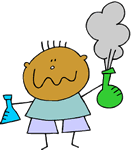|
|
|
Do you have students who don't "get it"? What about students who just don't seem motivated or interested? These resources help students who need scaffolding to build connections.
|
|
Many students need their work to be meaningful. Without meaning, some students become distracted and others do mediocre work. A WebQuest is an inquiry-based approach to learning that provides a meaningful task and quality resources to complete this task. A WebQuest can also be tailored to provide a variety of resources such as audio, video, visuals, and text. Choose a WebQuest that could be adapted for use in your classroom. Reformat the WebQuest for use as a PowerQuest using PowerPoint. Or, use Word to construct a WebQuest that adapts elements from a number of different WebQuests.
You don't have to develop an entire WebQuest
to bring meaningfulness to an activity. Use PowerPoint as a tool to
present scenarios or pose questions. Then, provide a web resource to provide information. For example, which cat would you
choose for your story? |
|
|
Some students are drawn to activities that connect to local or world events. These students excel when working with real, current events and activities. Provide students with choices that relate to individual interests, while still connecting to current information and ideas. Use online newspapers, magazines, radio, and television as starting points. Design an activity to uses a specific section or articles from an online news source. Consider choices at different reading levels. Or, focus on visuals. Create an activity title, overview, URL, and list of activities. News Sources
General News Sources
|
|
|
Some students do well with a brief overview of a topic and a single example. Other students need lots of practice to master a skill. Create a list of interactive activities students could use to practice or review specific skills. List the topic, standards, and URL.
Why use boring worksheets when you can find things that students will love to read? Use the following resources to check reading comprehension. Or, ask students to summarize or critique. Design a Word document that uses the high-interest content in one of the following pages. Include a title, photograph, link, and list of questions or problem to solve.
|
|
|
In most classrooms, students read at a wide range of reading levels. Be sure that you're selecting resources for a variety of levels. Also, look for websites that provided leveled reading resources. Create an activity and provide online readings at three different reading levels.
Use the resources below locate materials at varied reading levels.
Use resources to address different intelligences:
|
|
|
Students enjoy working with real facts, numbers, and documents. Rather than "watered down" resources found in workbooks, look for the "real thing" online. From the stock market to sports statistics, the web is filled with opportunities to manipulate real-world data. Locate a photograph, document, or piece of data that would bring a classroom topic to life. Design a short activity around this information.
|
|
|
Students need to be active. Many students are motivated by interactive resources that ask them to create, build, design, or make decisions. They also like to make decisions and participate in polls and surveys. There are lots of online tools for students to use. Try an online tool. Consider ways to get students excited about learning through the use of online and off-line tools such as Inspiration, Timeliner, KidPix, and PowerPoint. Tools
Go to Houghton Mifflin Evaluation Station. Explore tools for self-evaluating different types of writing such as Opinion Essay, Persuasive Essay, Compare-Contrast Essay, Research Report, Personal Narrative, and Story. This is good practice using the web for reading and interaction. Polls and Surveys Interactive Websites
|
|
|
You can't take students to Antarctica or the Amazon, but you can take students on a virtual field trip. Some students lack even basic experiences such as visiting a city or a farm. Use the Internet to help these students make a connection. Locate a virtual field trip. Where in a unit would you use this resources? To motivate at the beginning of a unit or review at the end? Brainstorm ways that you could create a virtual field trip with your class.
Create your own virtual field trip using the following PowerPoint templates (right-click and save to hard drive):
|
|
|
Some students need motivation to write, draw, or express themselves in other ways. Sometimes technology can provide motivating tools and resources. Develop an ecard activity that makes use of an ecard.
|
|
|
Students enjoy sharing their ideas with a real-world audience. Explore ways to provide connections for students. Go to Froogle and e-bay. Brainstorm ways that real-world products can be used in the classroom. Go to KidsLearn and explore their online projects. Plan to participate in this project. Or locate a class and write an email to the class. Or, create a nicenet forum.
|
|
|
Some students need a challenge. Ask students to think rather than copy through activities such as evaluating, critiquing, and creating. Design an activity that involves students in critiquing books reviews or websites created by other students.
|
|
